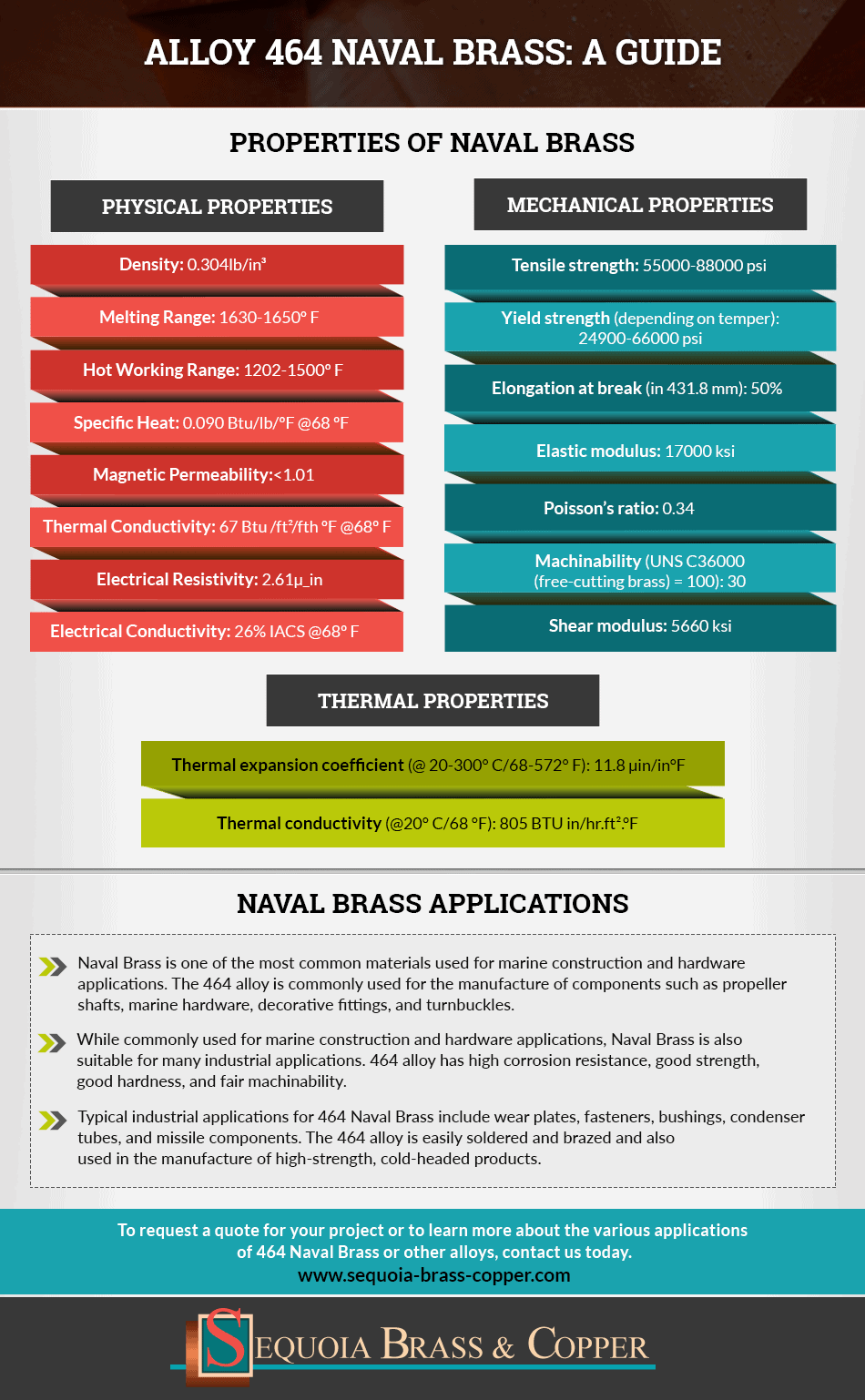As a base metal, copper freely forms metal alloys when you combine it with elements like aluminum, zinc, nickel, and tin. Naval brass, also known as C46400, is just one of the hundreds of available copper alloys. However, this material offers metal fabricators — particularly those in the marine industry — unique properties that make it compatible with several manufacturing methods and advantageous in a range of applications and environments.
At Sequoia Brass & Copper Inc. (SBC), we’ve been supplying our diverse client base with high-quality nonferrous metals for over 40 years. Read on to learn more about naval brass, its applications, and our various C46400 material offerings.
What Is 464 Naval Brass (C46400)?
464 naval brass is a type of copper-zinc-tin alloy containing approximately 59% copper, 40% zinc, 1% tin, and traces of lead. Because 464 naval brass has a maximum lead content of 0.2%, it’s considered a lead-free product.
Alloy 464 is a hard material with good tensile strength and rigidity. The addition of tin provides extra corrosion resistance in seawater and other mildly aggressive environments. The tin content also helps alloy C46400 achieve improved protection against dezincification, which is essentially a dealloying process. Tin halts the intrusion of saltwater at above-average temperatures. In addition to resisting corrosion, the material also holds up against stress corrosion cracking, galling, fatigue, and general wear.
Naval brass is categorized as part of a subfamily of alpha-beta or duplex brasses. The alloy received its name because of its frequent use in marine environments. Its durability and corrosion-resistant qualities make it suitable for both salt and freshwater applications. At SBC, alloy 464 is available in plate, rod, and sheet forms in various thicknesses and sizes.
464 Naval Brass Properties
The elemental makeup of naval brass gives the alloy its unique physical, mechanical, and thermal properties.
Physical Properties
- Density: 0.304 lb./in.³
- Melting range: 1,630-1,650º F
- Hot working range: 1,202-1,500º F
- Specific heat: 0.090 Btu/lb./º F @ 68º F
- Magnetic permeability: <1.01
- Thermal conductivity: 67 Btu/ft.²/fth.º F @ 68º F
- Electrical resistivity: 2.61μ_in.
- Electrical conductivity: 26% IACS @ 68º F
Mechanical Properties
- Tensile strength: 55,000-88,000 psi
- Yield strength (based on temper): 24,900-66,000 psi
- Elongation at break (in 431.8 mm): 50%
- Elastic modulus: 17,000 ksi
- Poisson’s ratio: 0.34
- Machinability [UNS C36000 (free-cutting brass) = 100]: 30
- Shear modulus: 5,660 ksi
Thermal Properties
- Thermal expansion coefficient (@ 20-300° C/68-572° F): 11.8 μin/in.° F
- Thermal conductivity (@20° C/68° F): 805 Btu in./hr.ft.² ° F
Naval Brass Applications
Among the most common material options for marine projects, naval brass is well-suited to component manufacturing for the following:
- Propeller shafts
- Turnbuckles
- Hardware
- Decorative fittings
However, C46400 is a versatile material. Its advantageous strength, hardness, and corrosion resistance — as well as its compatibility with machining, soldering, and brazing techniques — lend this brass to applications beyond marine environments and equipment. It’s also common to find this copper-zinc-tin alloy in cold-headed components such as:
- Valve stems
- Wear and condenser plates
- Heat exchanger and condenser tubes
- Welding rods
- Dies
- Bushings
- Fasteners
- Missile parts
464 Naval Brass Machinability
It’s the lead within the material composition of 464 brass that gives the alloy its machinability. Naval brass also offers particularly high hot workability, formability, and forgeability. Metal fabricators have multiple processes available to them for working with naval brass, with some examples including drawing, bending, blanking, and shearing.
The machinability of C46400 naval brass rod comes in at a “fair” rating of approximately 35% of C360 brass. Also called free-machining brass, C360 brass possesses a superior machinability rating of 100%. To provide a comparison between the composition of the two alloys, C360 contains more lead and no tin. It’s made up of approximately 61% copper, 35% zinc, 3% lead, and 0.35% iron.
Naval Brass Selection From SBC
At SBC, we offer naval brass in a range of forms for your convenience. Your options include:
- Uninhibited naval brass plates. Our 464 brass plates are available in both lengths and widths of 12, 18, or 24 inches. We offer thicknesses ranging from 0.25 to 2 inches.
- Uninhibited naval brass rods. Naval brass in rod form comes in lengths of 12, 36, or 72 inches. As for rod outer diameter (O.D.), they start at 0.5 and go up to 1 inch.
- Uninhibited naval brass sheets. Like our brass plates, you can choose from 464 alloy sheets of 12, 18, or 24 inches in length and width. They’re available in two thickness options: 0.1250 and 0.1875 inches.
Choose Sequoia Brass & Copper for Naval Brass
With common applications in both salt and freshwater environments, naval brass offers impressive durability, hardness, and corrosion resistance. While it’s highly popular in the marine sector, the copper-zinc-tin alloy is also known for its suitability in industrial projects. 464 brass is fairly easy to machine, and it’s an outstanding choice for hot forming and forging operations.
When choosing a distributor, it is essential to select an established supplier with a reputation for quality. Sequoia Brass & Copper is an industry-leading nonferrous metals supplier offering plate, sheet, and bar forms. We provide a broad mix of products and services featuring unsurpassed quality, including 464 naval brass, and have been serving the North American metal fabrication market since 1983. View the naval brass catalog here.
Our highly qualified team is dedicated to outstanding customer service and committed to providing our customers with the highest quality materials available. To request a quote for your project or to learn more about our various brass offerings, contact us today.

